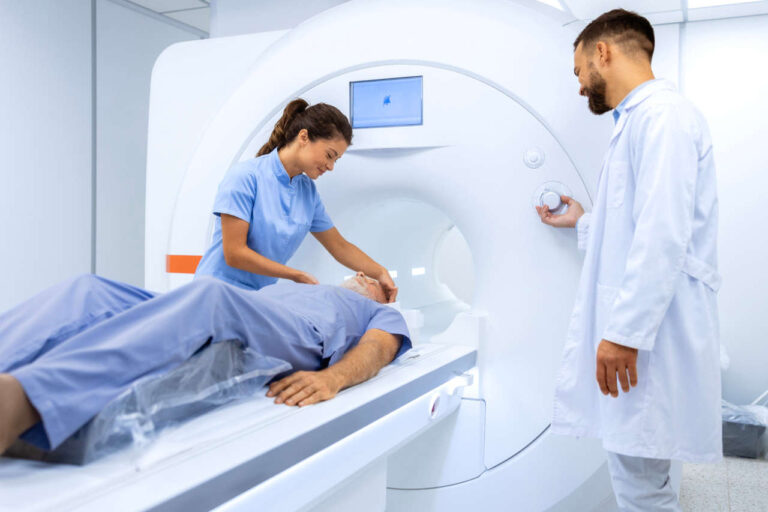
Graft-versus-host disease (GvHD) is one of the common complications of allogeneic transplantation — a procedure in which healthy stem cells taken from a donor are transplanted into the patient’s body. GvHD occurs when some of the newly transplanted donor’s cells (graft) do not recognize the patient’s (host) body and attack their healthy cells.
Speak to a Specialist About Copay Assistance
The presence of a specific white blood cell (the T-cell) from the donor recognizes the patient’s tissues or organs as a foreign threat and initiates an immune response against them.
The risk of graft-vs-host disease is higher in people who receive a transplant from a mismatched donor. Up to 50% of patients experience this complication during allogeneic transplantation.
GvHD can range from mild to severe, and in some cases, it could be life-threatening if not treated soon enough.
This article briefly explains GvHD, how it happens, and what to expect if you develop GvHD.
How Does Graft-Versus-Host Disease Develop?
Generally, your body’s immune system trains the immune cells to distinguish between the “self” (your cells) and “non-self” cells (infected cells or pathogens). In particular, the T-cells play this important function and recognize the body’s own cells and foreign intruders.
It does this by detecting the presence of specific proteins called human leukocyte antigens (HLA) or major histocompatibility complex (MHC proteins) in the cells. The HLA protein is like a name tag for every cell and has two types:
- MHC class I: Present on all nucleated cells of your body
- MHC class II: Present only on antigen-presenting cells (immune cells)
Every individual inherits a unique pattern of HLA protein from their parents, except identical twins.
After a stem cell (allogeneic) transplant, your bone marrow starts producing new blood cells from the donor stem cells. The new blood cells have the donor’s HLA pattern. When the newly produced T-cells encounter the HLA pattern of your body cells, they take them as foreign (non-self cells) and initiate a set of immune responses. This inflammatory response of donated cells attacks and damages the host’s tissues, sometimes leading to multiple organ failure.
What Are the Types of Graft-Versus-Host Disease?
GvHD can manifest as acute GvHD and chronic GvHD, depending on the timing of the onset and symptom duration after transplantation.
Acute GvHD

Acute GvHD usually develops within 3 months after the transplantation and can affect the skin, gastrointestinal system, or liver. The symptoms of acute GvHD sometimes start later. The following are some common symptoms you can expect if you develop an acute form of GvHD:
- Rash or blister-like lesions on the palms, soles, shoulders, and nape of the neck (seen in 70% of cases)
- Gastrointestinal issues such as intense diarrhea, nausea, vomiting, mucosal ulceration, and abdominal pain (seen in 74% of cases)
- Liver issues such as jaundice, elevated levels of liver enzymes (bilirubin and alkaline phosphatase), and pale-yellow urine (seen in 44% of cases).
Chronic GvHD
Chronic GvHD can develop at any time after a transplant; however, it most commonly occurs within 2 years. The symptoms of chronic disease are more severe than acute GvHD and affect multiple organs and systems of your body, such as mouth, skin, lungs, liver, genitals, GI tract muscle, and joints.
Symptoms of chronic GvHD may include:
- Skin changes (rash or itching)
- Vision changes
- Dry eyes or mouth sores
- Joint pain
- Fatigue
- Gastrointestinal issues such as cramps, nausea, vomiting, or diarrhea
- Gum disease
- Muscle weakness
- Recurrent infections
Can IVIG help? | Free IVIG Treatment Info
Who Is at High Risk of Developing GvHD?
The risk of developing GvHD is higher:
- If you receive a transplant from an HLA-mismatched donor who is related
- If you receive a transplant from an HLA-matched donor who is NOT related
- If the donated stem cells have a high number of T-cells
- If both the donor and recipient are older
- If the donor is pregnant or has been pregnant in the past
- If transplants occur between mismatched genders, for example, if the donor is male and the recipient is female, and vice versa
The risk of GvHD also varies depending on the source of stem cells, whether they are obtained from the donor’s bloodstream or bone marrow.
How Is GvHD Diagnosed and Treated?
Diagnosis and Tests
During a physical examination, your healthcare professional may diagnose GvHD based on certain symptoms, the findings of blood testing, and biopsies. A sample of tissue or cells is taken during a biopsy, and the sample is sent to a lab for analysis.
Treatment Strategies
To prevent GvHD from occurring, your healthcare provider will start you on prophylactic (preventative) medication that will suppress the immune system. Examples of medications used include cyclosporine, methotrexate, or tacrolimus. This helps to decrease the ability of the donor’s cells to mount an immune response against the host’s tissues.
If GvHD does occur, for mild symptoms such as skin rashes, steroid ointments are prescribed. For more severe cases, medications such as immunosuppressives (e.g., corticosteroids), anti-inflammatory medications (e.g., infliximab), and IVIG are used to dampen inflammation and ease the symptoms. These treatments will be tailored to you based on the severity and type of GvHD.
Are There Any Potential Benefits of Graft-Versus-Host Disease?
GvHD has certain advantages, even though it can have a detrimental effect on your quality of life. Any cancer cells that survive are tracked down and eliminated by the same immune system that attacked your healthy cells. We refer to this as the graft-versus-tumor effect.
How Can GvHD Be Prevented in Patients Undergoing Allogeneic Transplantation?
GvHD can be prevented in patients by carefully selecting the match donor. HLA-typing and matching are the two methods used to select the best possible match for transplantation.
REFERENCES:
- Malard, F., Holler, E., Sandmaier, B. M., Huang, H., & Mohty, M. (2023). Acute graft-versus-host disease. Nature Reviews Disease Primers, 9(1), 1-18. https://doi.org/10.1038/s41572-023-00438-1
- Shlomchik, W. D. (2007). Graft-versus-host disease. Nature Reviews Immunology, 7(5), 340-352. https://doi.org/10.1038/nri2000
- Blazar, B. R., Murphy, W. J., & Abedi, M. (2012). Advances in graft-versus-host disease biology and therapy. Nature Reviews Immunology, 12(6), 443-458. https://doi.org/10.1038/nri3212
- Choi, S. W., & Reddy, P. (2014). Current and emerging strategies for the prevention of graft-versus-host disease. Nature Reviews Clinical Oncology, 11(9), 536-547. https://doi.org/10.1038/nrclinonc.2014.102
- Justiz Vaillant, A. A., Modi, P., & Mohammadi, O. (2022). Graft Versus Host Disease. PubMed; StatPearls Publishing. https://www.ncbi.nlm.nih.gov/books/NBK538235/#:~:text=Graft%2Dversus%2Dhost%20disease%20(GvHD)%20is%20a%20systemic
- Ferrara, J. L., Levine, J. E., Reddy, P., & Holler, E. (2009). Graft-versus-host disease. The Lancet, 373(9674), 1550–1561. https://doi.org/10.1016/s0140-6736(09)60237-3












